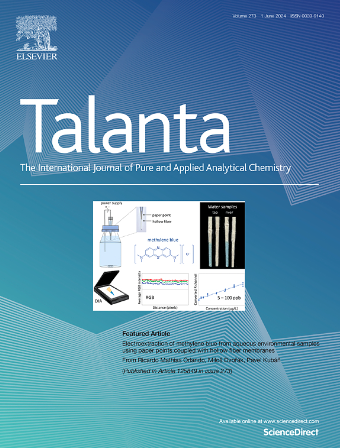表面增强拉曼散射标签实现了基于DNA条形码的海马三角体超灵敏分子鉴定
IF 6.1
1区 化学
Q1 CHEMISTRY, ANALYTICAL
引用次数: 0
摘要
基于DNA条形码的生物物种快速和精确识别在药物认证和生物医学诊断方面具有重要的潜力。在此,我们提出了一个聚合酶链反应(PCR) -表面增强拉曼散射(SERS)平台,该平台集成了SERS标签,用于高价值中药海马(Hippocampus trimaculatus)的超灵敏快速认证。SERS标签由金纳米星、近红外菁7拉曼报告器和羧化聚苯乙烯壳组成,在780 nm辐照下实现单粒子检测灵敏度。该标签在生理相关条件下(如磷酸盐缓冲盐水、血清、1 mM NaCl和pH 1 - 12)也表现出优异的胶体和SERS稳定性,信号变化小于5%。羧基化的聚苯乙烯壳使DNA有效功能化。利用这些进展,PCR-SERS检测方法可以在20个热循环中检测低至10拷贝/μL的基因组DNA (gDNA),在四种常见的掺假物种中对海马具有显著的特异性。值得注意的是,该方法将扩增要求降低到5个热循环(检测限为106拷贝/μL),并在不到30分钟内完成整个工作流程(传统qPCR, 20-30个循环,1-2小时)。除了中医验证之外,该PCR-SERS平台在从环境eDNA监测到护理点诊断等领域的快速核酸检测中具有广泛的适用性。本文章由计算机程序翻译,如有差异,请以英文原文为准。

Surface enhanced Raman scattering tag enabled ultrasensitive molecular identification of Hippocampus trimaculatus based on DNA barcoding
Rapid and precise DNA barcode-based identification of biological species holds significant potential for pharmaceutical authentication and biomedical diagnostics. Herein, we present a polymerase chain reaction (PCR)–surface-enhanced Raman scattering (SERS) platform that integrates SERS tags for ultrasensitive and fast authentication of Hippocampus trimaculatus, a high-value traditional Chinese medicine (TCM). The SERS tags are composed of gold nanostars, near-infrared cyanine7 Raman reporters and carboxylated polystyrene shells, which achieve single-particle detection sensitivity under 780 nm irradiation. The tags also show excellent colloidal and SERS stability under physiologically relevant conditions (e.g., phosphate buffer saline, serum, 1 mM NaCl, and pH 1–12), with signal variations less than 5 %. The carboxylated polystyrene shells enable efficient DNA functionalization. Leveraging these advancements, the PCR-SERS assay detects genomic DNA (gDNA) at concentrations as low as 10 copies/μL within 20 thermal cycles, with remarkable specificity for Hippocampus trimaculatus over four common adulterant species. Notably, the method reduces amplification requirements to 5 thermal cycles (detection limit of 106 copies/μL) while completing the entire workflow in less than 30 min (conventional qPCR, 20–30 cycles, 1–2 h). Beyond TCM verification, this PCR-SERS platform holds broad applicability for rapid nucleic acid detection in fields ranging from environmental eDNA monitoring to point-of-care diagnostics.
求助全文
通过发布文献求助,成功后即可免费获取论文全文。
去求助
来源期刊

Talanta
化学-分析化学
CiteScore
12.30
自引率
4.90%
发文量
861
审稿时长
29 days
期刊介绍:
Talanta provides a forum for the publication of original research papers, short communications, and critical reviews in all branches of pure and applied analytical chemistry. Papers are evaluated based on established guidelines, including the fundamental nature of the study, scientific novelty, substantial improvement or advantage over existing technology or methods, and demonstrated analytical applicability. Original research papers on fundamental studies, and on novel sensor and instrumentation developments, are encouraged. Novel or improved applications in areas such as clinical and biological chemistry, environmental analysis, geochemistry, materials science and engineering, and analytical platforms for omics development are welcome.
Analytical performance of methods should be determined, including interference and matrix effects, and methods should be validated by comparison with a standard method, or analysis of a certified reference material. Simple spiking recoveries may not be sufficient. The developed method should especially comprise information on selectivity, sensitivity, detection limits, accuracy, and reliability. However, applying official validation or robustness studies to a routine method or technique does not necessarily constitute novelty. Proper statistical treatment of the data should be provided. Relevant literature should be cited, including related publications by the authors, and authors should discuss how their proposed methodology compares with previously reported methods.
 求助内容:
求助内容: 应助结果提醒方式:
应助结果提醒方式:


